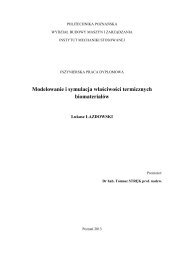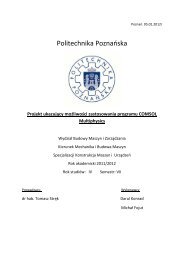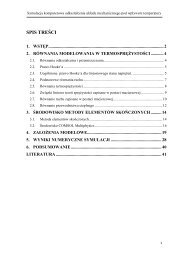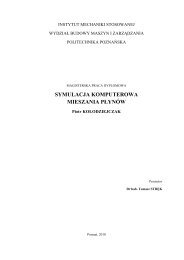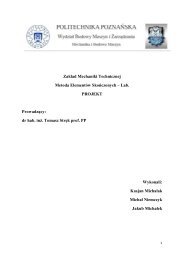Computer simulation of thermal convection in Rayleigh-Bénard cell ...
Computer simulation of thermal convection in Rayleigh-Bénard cell ...
Computer simulation of thermal convection in Rayleigh-Bénard cell ...
You also want an ePaper? Increase the reach of your titles
YUMPU automatically turns print PDFs into web optimized ePapers that Google loves.
Hubert Jopek<br />
<strong>Computer</strong> <strong>simulation</strong> <strong>of</strong> <strong>thermal</strong> <strong>convection</strong> <strong>in</strong> <strong>Rayleigh</strong>-<strong>Bénard</strong> <strong>cell</strong><br />
Chapter 3: Description <strong>of</strong> the geometry <strong>in</strong> <strong>Rayleigh</strong>-<strong>Bénard</strong> model<br />
The Geometry <strong>of</strong> the <strong>Rayleigh</strong>-<strong>Bénard</strong> model is presented below:<br />
Fig. 3.1: The fluid layer model.<br />
the top<br />
The model is a very long narrow fluid layer. There are fixed temperatures at<br />
T<br />
C<br />
and at the bottom<br />
Tw<br />
and the temperature at the bottom is higher so<br />
T<br />
w<br />
> T c<br />
. The difference <strong>of</strong> the temperature is expressed by the term δT<br />
= T w<br />
−Tc<br />
this is one <strong>of</strong> the control parameters <strong>of</strong> the system. Convection appears when the<br />
temperature gradient is big enough, consequently a small packet <strong>of</strong> fluid starts to<br />
move up <strong>in</strong>to the colder region <strong>of</strong> higher density. If the buoyant force caused by<br />
difference <strong>of</strong> density is big enough, then the pocket moves upward so fast that the<br />
temperature cannot drop and the convective flow appears. There is also possible<br />
that the buoyant force is not strong enough, <strong>in</strong> such a situation the temperature <strong>of</strong><br />
the pocket is able to drop before it can move up too much, and as a result fluid stays<br />
stable.<br />
and<br />
Fig. 3.2: Transition from <strong>thermal</strong> conduction to convective rolls <strong>in</strong> <strong>in</strong>f<strong>in</strong>ite twodimensional<br />
fluid layer.<br />
8



